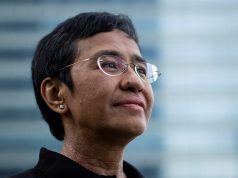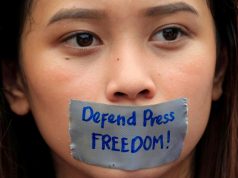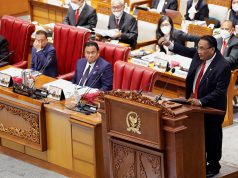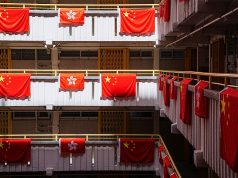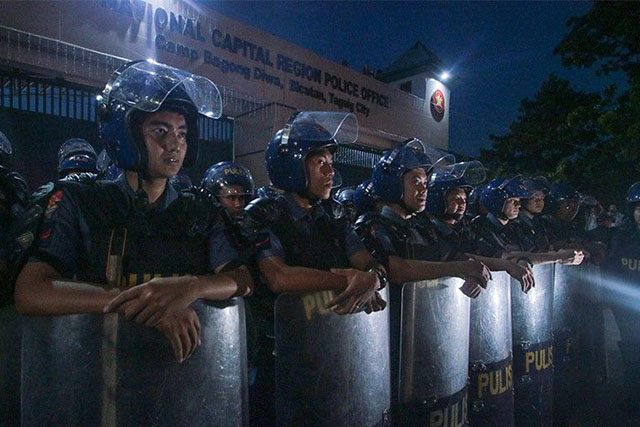
Policemen were seen shoving reporters and photographers covering the coverage of the Maguindanao massacre promulgation on Thursday, December 20.
A Twitter user shared a video of media workers near the gate of Camp Bagong Diwa in Taguig where they were being pushed by cops with riot shields and prevented from further taking pictures or videos.
Workers from various media outlets could be heard protesting the cops’ treatment of them when they were simply doing their job reporting on the ground.
The video was reportedly taken while journalists were waiting for the verdict of the decade-long case. Some of the exclamations heard were:
“Nag-co-cover lang tayo ah!”
“Parang Maguindanao na rin ‘to ah!”
“Puro media ‘tong mga tinutulak niyo o!”
“Sampung taon na simula nung nangyari ang Ampatuan Maguindanao Massacre, ganito pa rin ang trato sa media kanina sa labas ng Camp Bagong Diwa habang naghihintay ng verdict. Mahaba-haba pa ang laban,” the sharer, Twitter user @hzllobres, wrote.
“Nagco-cover lang tayo ah.”
Sampung taon na simula nung nangyari ang Ampatuan Maguindanao Massacre, ganito pa rin ang trato sa media kanina sa labas ng Camp Bagong Diwa habang naghihintay ng verdict. Mahaba-haba pa ang laban.#DefendPressFreedom #Fightfor58 pic.twitter.com/2d5dqkcMla
— hazel (@hzllobres) December 19, 2019
Toward the end of the video, a male voice presumed to be from a media worker said in a mixed tone of defeat and frustration, “Wala na, tinutulak lang tayo eh!”
Another Twitter user questioned the use of riot shields against media workers.
“Bakit hinaharang ang media?? With riot shields??” user @KimTomCan wrote.
Yesterday, tight security was enforced before the verdict was announced.
As early as 6 a.m. yesterday, the area was placed on lockdown and everyone who entered the premises was subjected to undergo strict security checks. Members of PNP’s Civil Disturbance Management were also stationed inside and outside the camp.
Maguindanao Rep. Esmael “Toto” Mangudadatu previously revealed that he asked Interior Secretary Eduardo Año to tighten the security.
The supporters of the Mangudadatu clan stayed inside the premises while protesters and supporters of the Ampatuan were allowed to stay outside the camp.
Yesterday, principal suspects of the Ampatuan, Maguindanao massacre were convicted of multiple counts of murder and sentenced to reclusion perpetua without parole for killing 58 people, including various media workers, in the worst election-related violence in recent history in 2009.
It is also considered the world’s single-day deadliest attack against journalists, where 32 lost their lives after being requested to cover Mangudadatu’s filing of the certificate of candidacy for the 2010 elections.
RELATED: 10 years since Maguindanao massacre, watchdog sees little change in safety protocols for journalists
The Supreme Court in 2012 banned live coverage of the Maguindanao massacre case after Datu Andal “Unsay” Ampatuan Jr., one of the perpetrators, argued that it would supposedly violate his rights to due process.
As early as the first week of December, media groups including Interaksyon and its sister news outlet, Philstar.com, appealed for the high court to allow the live coverage of the court ruling so that families of the victims can hear the live reading on the decision, considering most of them live in Mindanao.
The appeal was initiated by the National Union of Journalists of the Philippines, the Center for Media Freedom and Responsibility and the Philippine Center for Investigative Journalism.
In 2018, the Center for Media Freedom and Responsibility or CMFR reported that the media continues to experience “at least 99 cases of direct and indirect assaults” from July 1, 2016 to Oct. 31, 2018.
It pointed out that journalists continue to be killed in the line of duty, as well as be barred from covering events for the public’s interest.
The CMFR said most of the cases were perpetrated by state forces and public officials. These supposedly include officers of the Philippine National Police and the Armed Forces of the Philippines.




